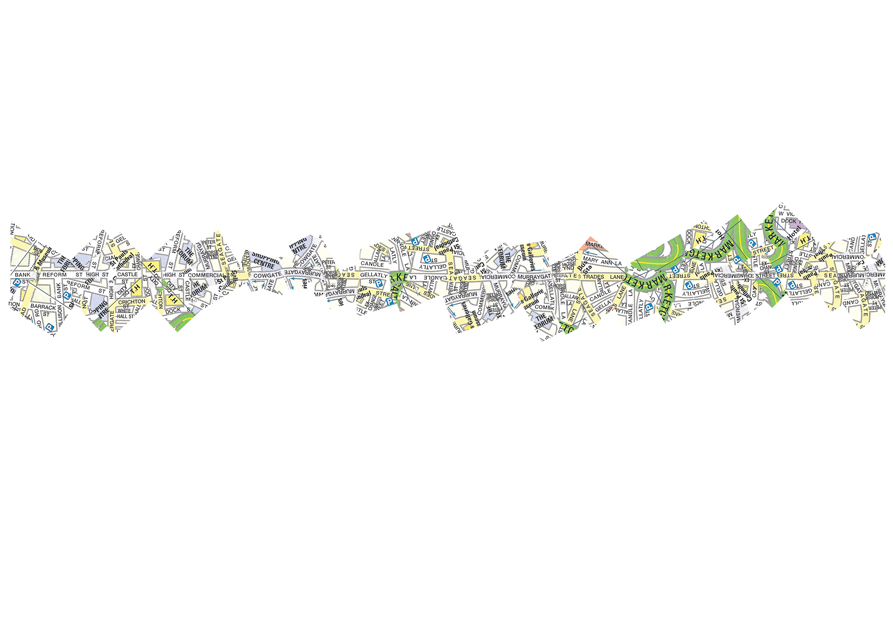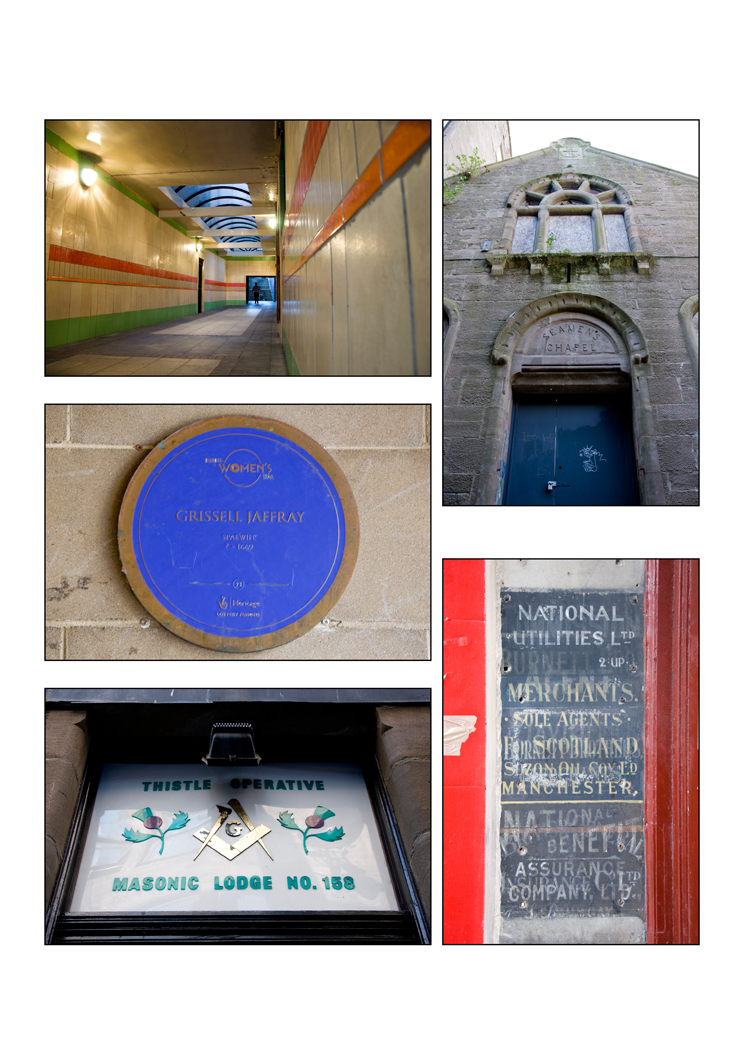DAVID FYANS
BA (hons, First Class)
Game One: (Heads/Tails)
Rules:
A psychogeographic game for 1 - ∞ players
Rules:
- The player should mark each side of a coin with left and right respectively using a permanent marker (I chose heads as left but this is arbitrary and up to the player).
- The game begins when the player leaves their chosen starting point. On exiting the door, they should face ahead and toss the coin once and start walking in the direction indicated.
- At each junction, the coin should be tossed and the direction followed until the next intersection. The player may take into account alleys, rights of way, bridges and other opportunities which present themselves.
- In instances where there is no left or right option, the player should take straight ahead as the alternative option. Corners may be turned if there is no alternative thoroughfare and the street continues.
- At intersections with multiple directions, the player should always only proceed with the first available option in any direction.
- The game may last for any duration of time, this may be decided beforehand. An alternative game may last for set number of coin tosses.
- A recording medium of some description should be used to gather observations and evidence made during the game (camera, audio recorder, notebook).
- The Player should absorb the general ambience in the different locations they traverse taking into account the sights, sounds, history, social matters, politics and any other elements deem interesting.
- The player is free to change the rules of this game or add their own variations before starting.
- A piece of work may be produced at the end of the game, this is optional.
Results:
Location: Dundee City Centre
Duration: 1 hour
Moves:
Left - Bank Street
Right - Reform Street
Left - High Street
Right - Castle Street
Right - Alley to City Square
Right - High Street
Left - Commercial Street
Right - Meadowside
Right - Cowgate
Right - Murraygate
Left - Horse Wynd
Right - Seagate
Left - Gellatly Street
Left - South Marketgate
Left - Candle Lane
Left - Seagate
Right - Commercial Street
Right - High Street
Right - Peter Street
Left - Seagate
Right - Trades Lane
Right - South Marketgate
Right - Commercial Street
Left - Exchange Street
Left - Castle Street
Left - Dock Street
Left - Commercial Street
Right - Seagate
Left - Horse Wynd
Left - High Street
Right - Commercial Street
Breakdown:
31 Chances
15 Left (48.39%)
16 Right (51.61%)
Post Match Analysis:
The game was formulated in an attempt to break out of my usual mode of psychogeographic practice, the derive, and to try to get a better handle on the work carried out by the Situationist International.
As it was a new experience, I decided to start with a duration of one hour. There was a degree of self consciousness and trepidation to begin with, unsure of how the game would play out, how circular or pointless the results may be. As always, the first step was the most difficult, overcoming the inertia of transferring a conceptual idea to a physical practice, the putting on of shoes and forcing onseself out of the safety and gravitational pull of internal thoughtspace.
Within 4 tosses of the coin, I arrived at what could only be described as an arcade, a covered passageway, tile lined and lit with a glass ceiling. The part of me that had recently been obsessed with Benjamin’s Arcades Project couldn’t help but find amusement at the situation. An external manifest of mental space, a guilty reminder of this as a personal research into my dissertation topic as an avoidance technique, in order to work out what the hell the Situationist were doing and out of frustration and opacity, I had decided to become Situationist, to see what the noise was about, to try to impose an order, albeit and order wrought from chance onto my usual aimless drift.
The game underway, I am cast adrift on the currents and eddies of chance. Caught in a backwash between the arterial routes between The Seagate, Commercial Street and Murraygate/High Street I go with the current, stumbling into new territories on my own doorstep that I’d never previously ventured into.
A short way along South Marketgate, the coin leads me to Candle Lane where a faded bronze inset on the wall, further obscured by a layer of almost opaque perspex informs me of the fact that several hundred years ago, I would have been underwater, in the depths of the Tay until the land was clawed back and reclaimed to cope with the necessity for industrial space around the thriving docks. Candle Lane takes its name from a candleworks which was located on the site to process and make candles from blubber at the weight of Dundee’s whaling.
Candle lane also contains the ruinous shell of the Seaman’s Chapel, designed by the architect David Mitchell as a “a neat, substantial and commodious edifice without wasting money on costly ornamental detail” constructed in 1881 with the adjoining Sailor’s Home, which has recently been redeveloped into a complex of 12 small, featureless, modern apartments estimated to be worth £154,950 each, a stark contrast from the meagre £12,413 which both the Home and the Chapel cost to build which came in at £200 less than the original budget.
Turns later, in Peter Street, I find a blue plaque for Grissell Jaffray, the last person in Dundee to be strangled and burned as a witch in 1669. On checking the map, I find a straight line between Peter Street and the unmarked alleged site of her burial in the Howff echoing the course of the Scourin Burn which runs under Meadowside, a line of confluence between water and old energies. Opposite Inex-Mica, my favourite city centre, old school hardware shop which sells everything from mortice locks and screws to lightbulbs to pots and pans to gardening tools is 22 Peter Street is home to the Thistle Operative Masonic Lodge No.158 behind an unassuming black gloss door, no doubt countless strange rituals and suspect business deals have been carried out.
Another few turns around the currents around Commercial Street and The Seagate lead me to No. 3 Seagate where a beautiful ghost sign still adorns the doorway. A perfect depiction of the changing face of city centre business, National Utilities Ltd, Commission Burnett, National Benefit, Assurance Company Ltd, Insurance Company Ltd and others all coexist and share the same space, both visibly on the sign, and liminally throughout time.
And so, an hour was up. I took to the maps to formalise the record of the game, plotting the turns taken, calculating statistics and trying to form a synopsis of what I’d just experienced. I would say that the nature of playing a game of chance, in some ways, obstructed my observations to a degree. I think at times I was definitely concentrating more on game mechanics than my specific surroundings but I managed to take in some a few areas, incredibly close to the area that my daily life plays out in, which i had never previously encountered.
I produced a series of visual maps in response to the game, one of which, a linear map taking the sections which I traversed of each road and collaging them together, an idea which worked much better in my head than in reality which also caused my computer to crash on a couple of occasions. The results which i was most pleased with were the abstracted maps, a solid black rendering of the roads which had been used throughout the game, its inverse, a ghost map of the same space depicted only by the shapes of the buildings and spaces between throughfares and a directional line map showing start and end points with arrows denoting the flow of activity.
There was a degree of enjoyment from being at the mercy of the coin, and almost monoideaism that the coin, the binary decision outwith my control, where, under normal circumstances, I would have wandered aimlessly in my quest, unwilling to double back or repeat sections, here, I had no excuse. I would definitely be interested in further explorations of game navigation, perhaps with different modifiers or possibly a different game altogether, possibly with a clearer goal for the outcome in mind.




